Damaged Amazon Adds to Global Warming
Air Date: Week of March 26, 2021
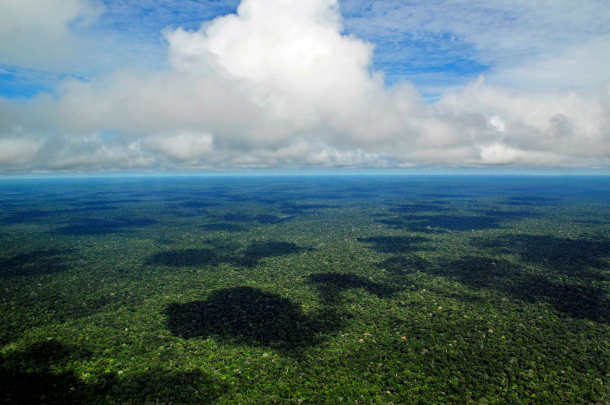
A bird’s eye view of the Amazon Rainforest near the city Manaus. (Photo: Neil Palmer, CIAT, Wikimedia Commons, CC BY-SA 2.0)
The first broad study of all greenhouse gases in the Amazon rainforest reveals that on balance the damaged ecosystem is now a net contributor to climate change. Part of the problem comes from local damaging activities like logging, dam-building, and cattle ranching. But planet-wide warming is also disrupting the water cycles in the Amazon, intensifying floods and drought that create more greenhouse gases and further decrease the ecosystem's ability to capture and store carbon emissions. Lead author and professor at Skidmore College, Kristofer Covey, joins Host Steve Curwood to explain the study.
Transcript
BASCOMB: From PRX and the Jennifer and Ted Stanley studios at the University of Massachusetts Boston, this is Living on Earth. I’m Bobby Bascomb
CURWOOD: And I’m Steve Curwood
The vast Amazon Rainforest is now likely adding to global warming. This astounding news comes from research analyzing a wide range of emissions from the tropical forest system, not just carbon dioxide. Part of the problem stems from cutting and burning the forest, as well as dams and cattle ranching that promote the formation of methane. But even more ominous is the concern that the world-wide rise in temperatures is speeding up water cycles, making for extremes between floods and drought, and changing the biochemistry of the rainforest. Not only is the Amazon the most biologically diverse ecosystem on the planet, but its trees also absorb some 2 billion tons of carbon dioxide every year. But the increased release of methane and other powerful greenhouse gases like nitrous oxide appear to be helping tip the Amazon toward adding to climate disruption. For more on this, we turn to the study's lead author and biogeochemist Kristofer Covey at Skidmore College, and he joins us now. Kristofer, welcome to Living on Earth!
COVEY: Well, thanks, Steve. I'm really excited to be here.
CURWOOD: So this is a fascinating and concerning study that you have published here. So what did you find?
COVEY: We realize there's been a ton of climate research that's been done in the Amazon and what we see is obviously, CO2 coming in, CO2 going out. We see fires, the sort of soot that comes off of the fires, that can change the color of the atmosphere, trees transpire water, and that can have a cooling impact. Clearing changes the color of the forest, and that changes the way that sunlight bounces off or is absorbed. We looked at methane emissions, both from wet soils, but also directly from trees. And so what we saw was that when you start to add all of this up and look at the scale of the whole Amazon Basin, that the net effect of that right now appears to us that it's most likely that the Amazon is actually warming climate.
CURWOOD: So I ran out of fingers to count all those factors that you looked at, give me the 4-1-1 about some of them. I mean, traditionally, we talked about carbon dioxide, CO2, humans are forcing more CO2 in the atmosphere, and that's what's warming the planet. But your study says, well, yeah, "CO2, but-" what are those other "buts" in some detail for me?
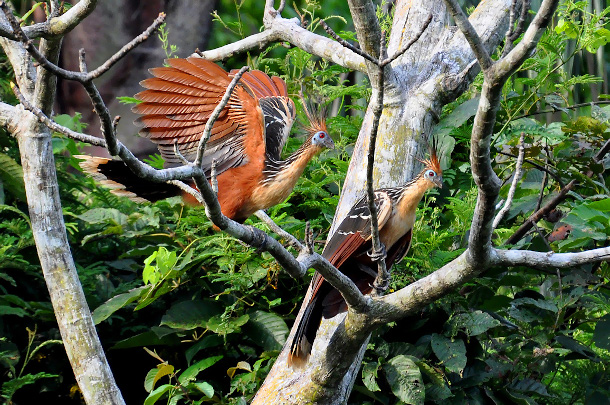
It is estimated that ten percent of the known species in the world is found in the Amazon rainforest. Pictured are two hoatzins, also known as the skunk bird or Canje pheasant. (Photo: Cláudio Dias Timm, Wikimedia Commons, CC BY-SA 2.0)
COVEY: Yeah, so well, CO2, obviously, is huge in the Amazon, you're talking about a continuing reserve of over 100 billion tons. But we also see, for instance, methane as a really important greenhouse gas that comes out of all natural ecosystems. That's not a new finding in any way. What's special in the Amazon is that a few years ago, one of my colleagues, Sunitha Pangala, went out and measured tree bark in the wet, flooded Amazon and found a lot of methane coming directly out of bark. And what's happening is it's being produced in the soil just as it would in any wetland. Well, normally, the water sort of traps that in. But these trees stick the roots down into the soil, and they're drawing that methane out of the wet soil, and they're acting like straws and bringing it up into the atmosphere. It turns out, that's a lot of methane, it's about three and a half percent of all methane put into the atmosphere. Another one, for example, is N2O. It's coming out of soils, it's coming out of trees. It's the result of land clearance, but it's also present before you clear land. And biological volatile organic compounds: they're fascinating because they don't have a whole lot of direct impacts on climate, they can. But their big effect is that they change the way other gases like CH4, for example, break down in the atmosphere. And so all of these impacts are interacting with each other in real time. We've known that this can happen in these systems, but starting to tie it all together onto one balance sheet can be incredibly difficult.
CURWOOD: Yeah, I'm not gonna disagree with you about that. We've been saying the Amazon is the lungs of the planet, and you have to stop cutting it because it's protecting us from climate disruption. But now you're saying it's part of the climate disruption party?
COVEY: Well, I think to say that the Amazon is part of the climate disruption is, is really missing a key part of our understanding of how terrestrial ecosystems work, which is that terrestrial ecosystems all around the world are constantly putting out greenhouse gases, taking them up. And we've actually known for some time, there was a paper published in Nature in 2016, that showed that on the net, all of the world's forests are emitting more greenhouse gases than they're taking up. But this is sort of the natural ecosystem processes. And that total, isn't what matters so much is how we are affecting that total, and the change that results from what we do on a piece of land. And one of our really key findings from looking at all of these things is that the vast majority of human activities in the Amazon: deforestation, mining, conversion to agriculture, this basket of things that we're doing down there, the vast majority of those, increase net warming. So rather than looking at that total, let's look at how we are influencing that total. And that's not a good picture, what we see there is that we have over the past half century, dramatically reduced the carbon sink of the Amazon, and in many cases, a bunch of these other factors as well, were increasing warming. And that change is what's really so frightening.
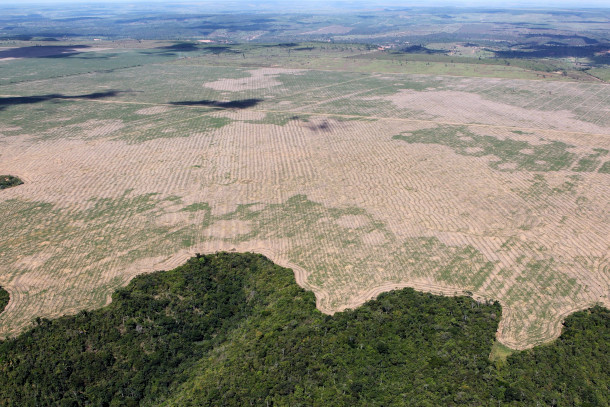
Deforestation in the Maranhão state of Brazil in 2016. By 2018, it was estimated that around 17% of the Amazon had been deforested. (Photo: Ibama, Wikimedia Commons, CC BY 2.0)
CURWOOD: And of course, they're building dams down there, which really can generate a lot of methane.
COVEY: I think the dam issue speaks to the tremendous complexity of the environmental challenges that we face. Because energy, obviously, if you read through the IPCC report, and look at where our emissions are coming from, and where the pathways that will get us to a sustainable climate are, many of them have to do with zero carbon energy. And then you put in a dam in the Amazon that's making low carbon or zero carbon energy, but we have to be concerned about the fact that we've just inundated a huge area and we're going to have a giant pulse of methane that's going to be released to the atmosphere. And I think that's another key point that we're trying to make with the paper is that we're going to be leaning increasingly on these ecosystems, not only for climate, but for a huge number of benefits. And so what we need to do is put as many of these arrows onto the diagram, understand them in as much depth and complexity as we can, and try and really embrace the complexity of the challenges facing the environment ahead. If we can't do that, we're not going to find ourselves on a sustainable path going forward.
CURWOOD: Kris, to what extent is there a feedback loop of warming now happening in the Amazon?
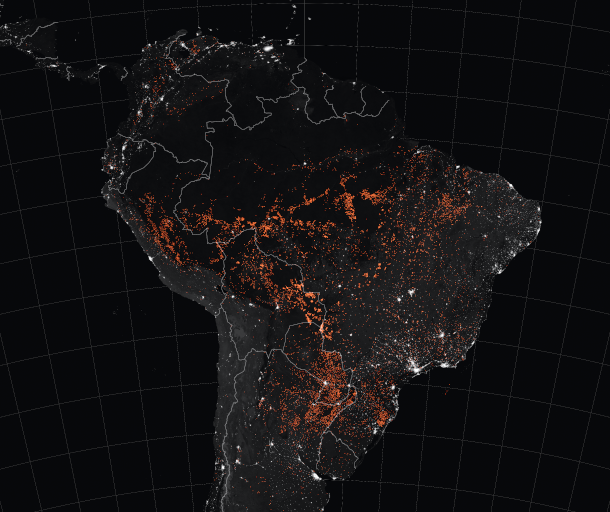
As warming and slash-and-burn deforestation continues, the Amazon rainforest becomes more susceptible to uncontrolled forest fires. The orange dots on this image mark the location of fires between August 15th and August 22nd in 2019. (Photo: Joshua Stevens, using MODIS data from NASA, Wikimedia Commons, public domain)
COVEY: Yeah, that's a great question. And something that I think is right at the front of climate researchers minds in the Amazon. And and I think that there's a pretty clear conceptual framework and the beginning of really good measurements to show that, as the Amazon warms, we're seeing the drought season come on earlier, we're seeing it last longer, potentially getting drier. And with that then, that's driving tree mortality. And dead trees burn a lot easier than live trees. And so then we're seeing the fire seasons being much more dramatic, burning much larger areas. And then as that happens, of course, as my colleague, Tom Lovejoy, who's on the paper, pointed out with Carlos Nobre a couple years ago, we're approaching very rapidly this point where the ecosystem itself is at the edge of potential collapse. The trees drawing moisture out of the ground, are seeding the rainfall that makes the Amazon a rain forest. And so you can see yourself, as you cut one tree, there's a little less moisture in the atmosphere as you cut the next tree, there's a little bit less. And so there's a conceptual last tree, where this isn't a rainforest anymore. And climate exacerbates that process and puts us closer to that tipping point.
CURWOOD: So we're talking about the Amazon, but it's not in isolation, we have an overall warming planet. And we're seeing also, especially from the High Arctic, with the warming a lot of releases of warming gases, methane and CO2. To what extent is the is the Amazon really caught in this overall feedback loop we have going on on the planet, do you think?
COVEY: Yeah, well, I think the Amazon is both at the center of that and a symptom of that, right? So the Amazon is feeding back into global climate where now it's now very clear that the degradation there has reduced to the carbon sink, to the point where we can start having conversations about whether there is a general carbon sink there anymore. And then that, of course, the release from the black carbon from all of the fires going into the atmosphere is warming, that warming is most extreme at the poles. And so it's an interesting story about the interconnectivity of our entire planet, right, warming from the Amazon is then driving warming in the Arctic. And along with a bunch of other places, we're starting to have this conversation around tipping points. And all of these tipping points are interconnected, it starts to bring to mind some of these tail risk scenarios that we talk about in climate change.
CURWOOD: So what's the solution here?
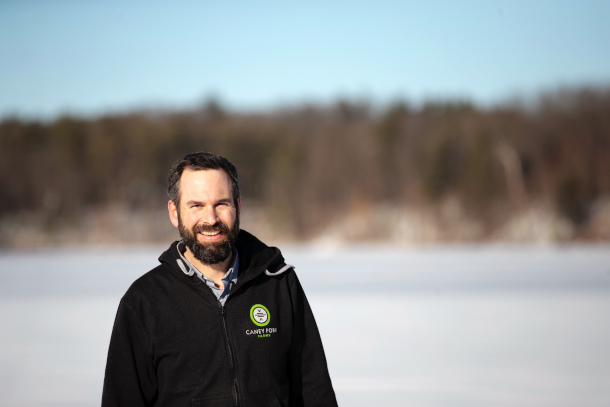
Kristofer Covey is a biogeochemist and Visiting Assistant Professor at Skidmore College. (Photo: Courtesy of Sarah Condon-Meyers)
COVEY: Well, I think the first thing I want to say is that the solution is certainly not to keep deforesting the Amazon, there is no silver lining to deforestation. Climate aside, let's assume for a second, there were no climate change. Wouldn't that be wonderful? Even in that case, the Amazon is still the largest store for biodiversity on the planet, it still has this gorgeous and unique river network unprecedented on the planet. It's still home to countless indigenous people who depend on it for their daily existence, right? And so there's so much to be had from protecting and restoring this great forest. And so I would say the solution is protect and restore. So how do we do that? We look at the social drivers of change. And we engage with the communities on the ground, with the people on the ground who are working at the source to halt deforestation, working with local communities, and working on integrated solutions to those problems.
CURWOOD: So the Amazon basin covers much of South America but the bulk of it, I think 60%, is in Brazil. Now the US is currently talking with Brazil about the environment prior to the big international negotiations on climate known to the UN as COP26. What are your hopes for a conversation between the United States and Brazil leading up to those climate negotiations?
COVEY: I've been happy to see some small attention in the news asking for the Biden administration to apply pressure on deforestation in Brazil in particular. And obviously, there are huge considerations in the geopolitical relationship between the United States and a massive country like Brazil. There should be a lot of things in those negotiations probably as complicated as the biogeochemistry of the Amazon, right? But as someone who's just spent a couple years with people who've been working for many, many years in that region looking at deforestation, thinking about its impact on global climate. From my perspective, if there were ever a time to expend some political capital, trying to save some natural capital, this is the time and so I would encourage the Biden administration to put deforestation at the center of its conversation with Bolsonaro and his administration.
CURWOOD: Kristofer Covey is a biogeochemist and teaches environmental studies and science at Skidmore College. Thank you so much for taking the time with us today.
COVEY: Thanks, Steve. Appreciate it.
Links
Living on Earth wants to hear from you!
Living on Earth
62 Calef Highway, Suite 212
Lee, NH 03861
Telephone: 617-287-4121
E-mail: comments@loe.org
Newsletter [Click here]
Donate to Living on Earth!
Living on Earth is an independent media program and relies entirely on contributions from listeners and institutions supporting public service. Please donate now to preserve an independent environmental voice.
NewsletterLiving on Earth offers a weekly delivery of the show's rundown to your mailbox. Sign up for our newsletter today!
 Sailors For The Sea: Be the change you want to sea.
Sailors For The Sea: Be the change you want to sea.
 Creating positive outcomes for future generations.
Creating positive outcomes for future generations.
 Innovating to make the world a better, more sustainable place to live. Listen to the race to 9 billion
Innovating to make the world a better, more sustainable place to live. Listen to the race to 9 billion
 The Grantham Foundation for the Protection of the Environment: Committed to protecting and improving the health of the global environment.
The Grantham Foundation for the Protection of the Environment: Committed to protecting and improving the health of the global environment.
 Contribute to Living on Earth and receive, as our gift to you, an archival print of one of Mark Seth Lender's extraordinary wildlife photographs. Follow the link to see Mark's current collection of photographs.
Contribute to Living on Earth and receive, as our gift to you, an archival print of one of Mark Seth Lender's extraordinary wildlife photographs. Follow the link to see Mark's current collection of photographs.
 Buy a signed copy of Mark Seth Lender's book Smeagull the Seagull & support Living on Earth
Buy a signed copy of Mark Seth Lender's book Smeagull the Seagull & support Living on Earth

